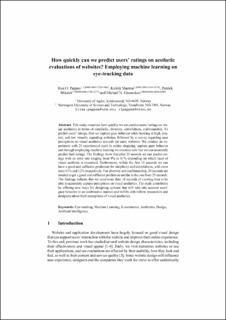How Quickly Can We Predict Users’ Ratings on Aesthetic Evaluations of Websites? Employing Machine Learning on Eye-Tracking Data
Peer reviewed, Journal article
Accepted version

View/
Date
2020Metadata
Show full item recordCollections
Original version
Lecture Notes in Computer Science (LNCS). 2020, 12067 429-440. https://doi.org/10.1007/978-3-030-45002-1Abstract
Abstract. This study examines how quickly we can predictusers’ ratings on vis-ual aesthetics in terms of simplicity, diversity, colorfulness, craftsmanship.To predict users’ ratings, first we capturegaze behaviorwhile looking at high, neu-tral, and lowvisuallyappealing websites, followed by a survey regarding user perceptions on visual aesthetics towards the samewebsites.We conduct an ex-periment with 23 experienced users in online shopping, capture gaze behavior andthrough employing machine learning weexamine how fast we can accurately predict their ratings. The findings showthat after 25 seconds we can predict rat-ings with an error rate ranging from 9% to 11% dependingon which facet of visual aesthetic is examined. Furthermore, within the first 15 seconds we can have a goodand sufficientprediction for simplicity and colorfulness, with error rates 11% and 12% respectively.For diversity and craftsmanship, 20 seconds are needed to get a good and sufficient prediction similar to the one from 25 seconds.The findings indicate that we need more than 10 secondsof viewing timeto be able to accurately capture perceptions on visual aesthetics. The study contributes by offering new ways fordesigningsystems that will take into account users’ gaze behavior in an unobtrusive manner and will be able inform researchers and designers about their perceptions of visual aesthetics.